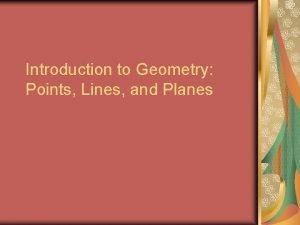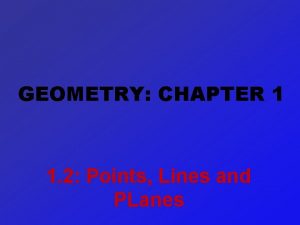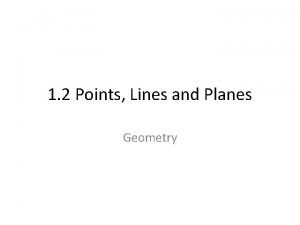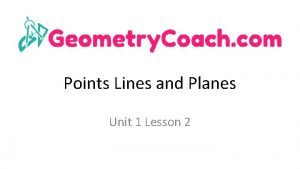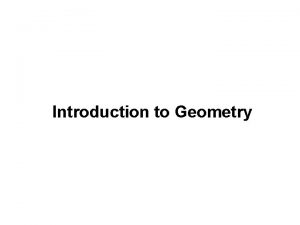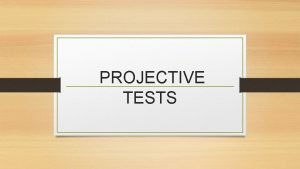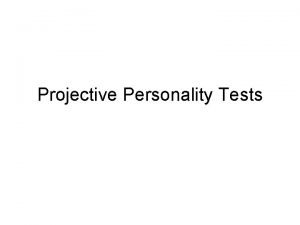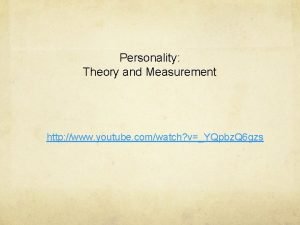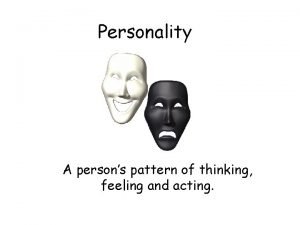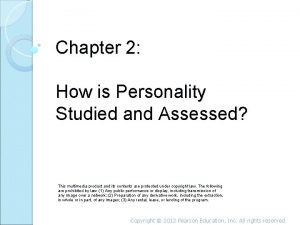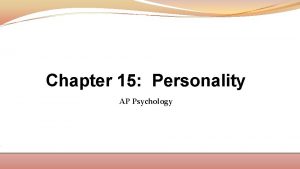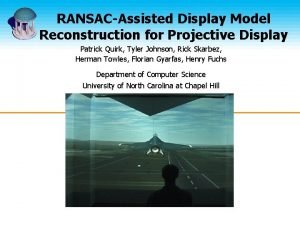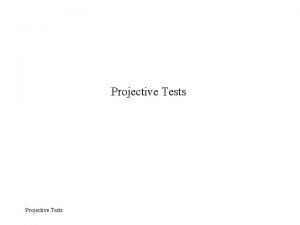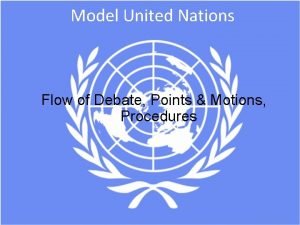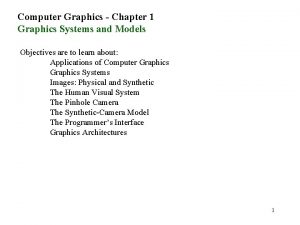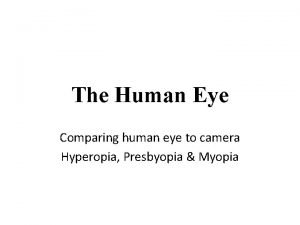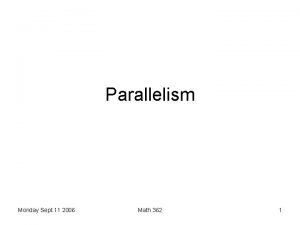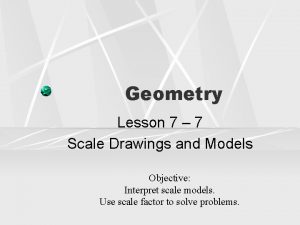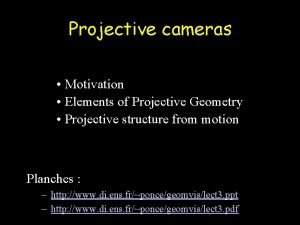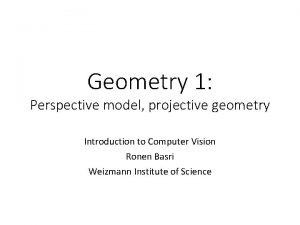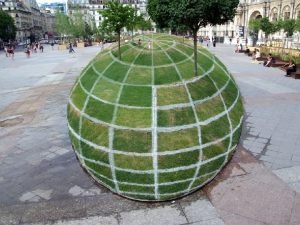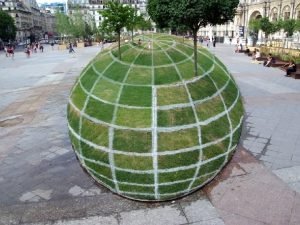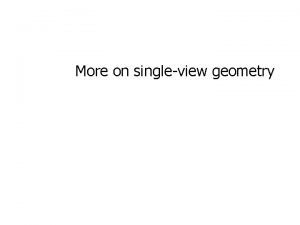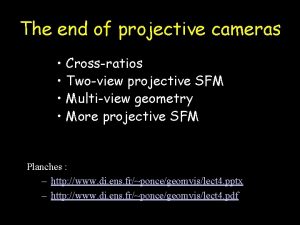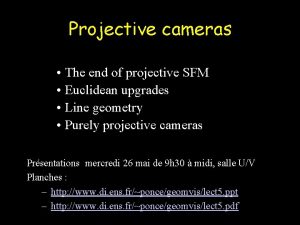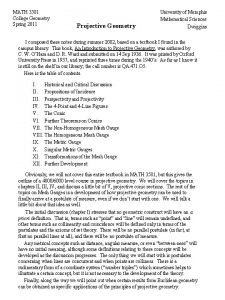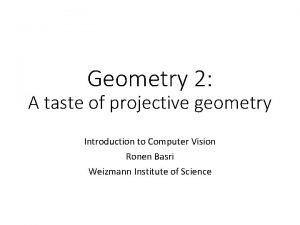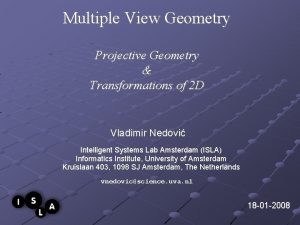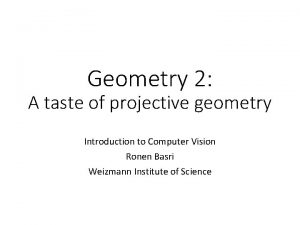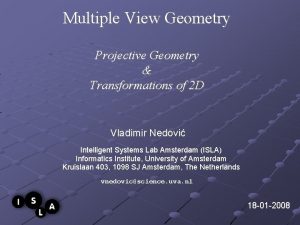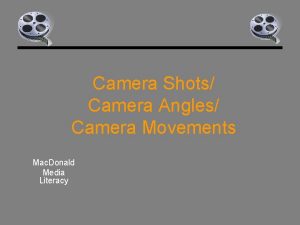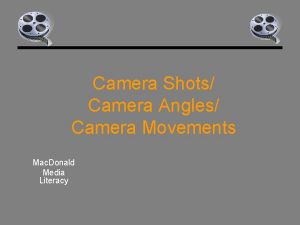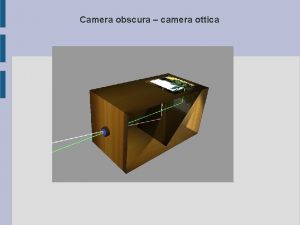Projective Geometry and Camera model Class 2 points























































- Slides: 55

Projective Geometry and Camera model Class 2 points, lines, planes conics and quadrics transformations camera model Read tutorial chapter 2 and 3. 1 http: //www. cs. unc. edu/~marc/tutorial/ Chapter 1, 2 and 5 in Hartley and Zisserman

Homogeneous coordinates Homogeneous representation of 2 D points and lines The point x lies on the line l if and only if Note that scale is unimportant for incidence relation equivalence class of vectors, any vector is representative Set of all equivalence classes in R 3 (0, 0, 0)T forms P 2 Homogeneous coordinates Inhomogeneous coordinates but only 2 DOF

Points from lines and vice-versa Intersections of lines The intersection of two lines and is Line joining two points The line through two points Example and is Note: with

Ideal points and the line at infinity Intersections of parallel lines Example tangent vector normal direction Ideal points Line at infinity • Line at infinity is a collection of all the points at infinity as x 1/x 2 varies, i. e. all Possible directions Note that in P 2 there is no distinction between ideal points and others

3 D points and planes Homogeneous representation of 3 D points and planes The point X lies on the plane π if and only if The plane π goes through the point X if and only if

Planes from points (solve as right nullspace of )

Points from planes (solve as right nullspace of Representing a plane by its span • M is 4 x 3 matrix. Columns of M are null space of )

Lines • Line is either joint of two points or intersection of two planes Representing a line by its span: two (4 dof) vectors A, B for two space points Dual representation: P and Q are planes; line is span of row space of Example: X-axis (Alternative: Plücker representation, details see e. g. H&Z)

Points, lines and planes • Plane defined by join of point X and line W is the null space of M • Point X defined by the intersection of line W with plane is the null space of M

Conics Curve described by 2 nd-degree equation in the plane or homogenized or in matrix form with 5 DOF:

Five points define a conic For each point the conic passes through or stacking constraints yields Conic c is a null vector of the above matrix

Tangent lines to conics The line l tangent to C at point x on C is given by l=Cx x l C

Dual conics A line tangent to the conic C satisfies In general (C full rank): Dual conics = line conics = conic envelopes Points conic lie on a point lines are tangent to the point conic C; conic C is the envelope of lines l

Degenerate conics A conic is degenerate if matrix C is not of full rank e. g. two lines (rank 2) e. g. repeated line (rank 1) Degenerate line conics: 2 points (rank 2), double point (rank 1) Note that for degenerate conics

Quadrics and dual quadrics (Q : 4 x 4 symmetric matrix) • • 9 d. o. f. in general 9 points define quadric det Q=0 ↔ degenerate quadric tangent plane • Dual Quadric: defines equation on planes • relation to quadric (non-degenerate)

2 D projective transformations Definition: A projectivity is an invertible mapping h from P 2 to itself such that three points x 1, x 2, x 3 lie on the same line if and only if h(x 1), h(x 2), h(x 3) do. Theorem: A mapping h: P 2 is a projectivity if and only if there exist a non-singular 3 x 3 matrix H such that for any point in P 2 reprented by a vector x it is true that h(x)=Hx Definition: Projective transformation or 8 DOF projectivity=collineation=projective transformation=homography

Transformation of 2 D points, lines and conics For a point transformation Transformation for lines Transformation for conics Transformation for dual conics

Fixed points and lines (eigenvectors H =fixed points) ( 1= 2 pointwise fixed line) (eigenvectors H-T =fixed lines)

Hierarchy of 2 D transformations transformed squares invariants Projective 8 dof Concurrency, collinearity, order of contact (intersection, tangency, inflection, etc. ), cross ratio Affine 6 dof Parallellism, ratio of areas, ratio of lengths on parallel lines (e. g midpoints), linear combinations of vectors (centroids). The line at infinity l∞ Similarity 4 dof Euclidean 3 dof Ratios of lengths, angles. The circular points I, J lengths, areas.

Projective geometry of 1 D The cross ratio Is invariant under projective transformations in P^1. Four sets of four collinear points; each set is related to the others by a line projectivity Since cross ratio is an invariant under projectivity, the cross ratio has the same value for all the sets shown

Concurrent Lines Four concurrent lines l_i intersect the line l in the four points x_i; The cross ratio of these points is an invariant to the projective transformation of the plane Coplanar points x_i are imaged onto a line by a projection with center C. The cross ratio of the image points x_i is invariant to the position of the image line l

A hierarchy of transformations • Euclidean transformations (rotation and translation) leave distances unchanged • Similarity: circle imaged as circle; square as square; parallel or perpendicular lines have same relative orientation • Affine: circle becomes ellipse; orthogonal world lines not imaged as orthogonoal; But, parallel lines in the square remain parallel • Projective: parallel world lines imaged as converging lines; tiles closer to camera larger image than those further away. Similarity Affine projective

The line at infinity l is a fixed line under a projective transformation H if and only if H is an affinity Note: not fixed pointwise

Affine properties from images projection rectification Two step process: 1. Find l the image of line at infinity in plane 2 2. Plug into H_pa Image of line at infinity in plane

Affine rectification l∞ v 1 l 2 l 3 l 4 v 2

The circular points Two points on l_inf which are fixed under any similarity transformation Canonical coordinates of circular points The circular points I, J are fixed points under the projective transformation H iff H is a similarity

The circular points Two points on l_inf: Every circle intersects l_inf at circular points “circular points” Circle: Line at infinity Algebraically, encodes orthogonal directions l∞

Conic dual to the circular points l∞ The dual conic is fixed conic under the projective transformation H iff H is a similarity Note: has 4 DOF (3 x 3 ho mogeneous; symmetric, determinant is zero) l∞ is the nullvector

Angles Euclidean: Projective: (1) (l and m orthogonal) Once is identified in the projective plane, then Euclidean angles may be measured by equation (1)

Transformation of 3 D points, planes and quadrics For a point transformation Transformation for lines Transformation for conics Transformation for dual conics (cfr. 2 D equivalent)

Hierarchy of 3 D transformations Projective 15 dof Affine 12 dof Similarity 7 dof Euclidean 6 dof Intersection and tangency Parallellism of planes, Volume ratios, centroids, The plane at infinity π∞ Angles, ratios of length The absolute conic Ω∞ Volume

The plane at infinity π is a fixed plane under a projective transformation H iff H is an affinity 1. 2. 3. 4. canonical position contains directions two planes are parallel line of intersection in π∞ line // line (or plane) point of intersection in π∞

The absolute conic Ω∞ is a (point) conic on π. In a metric frame: or conic for directions: (with no real points) The absolute conic Ω∞ is a fixed conic under the projective transformation H iff H is a similarity 1. Ω∞ is only fixed as a set 2. Circle intersect Ω∞ in two circular points 3. Spheres intersect π∞ in Ω∞

The absolute dual quadric Set of planes tangent to an ellipsoid, then squash to a pancake The absolute dual quadric Ω*∞ is a fixed conic under the projective transformation H iff H is a similarity 1. 8 dof ( symmetric matrix, det is zero) 2. plane at infinity π∞ is the nullvector of Ω∞ 3. Angles:

Camera model Relation between pixels and rays in space ?

Pinhole camera

Pinhole camera model linear projection in homogeneous coordinates!

Pinhole camera model

Principal point offset principal point

Principal point offset calibration matrix

Camera rotation and translation ~

CCD camera

General projective camera 11 dof (5+3+3) non-singular intrinsic camera parameters extrinsic camera parameters

Radial distortion • Due to spherical lenses (cheap) • Model: R R straight lines are not straight anymore http: //foto. hut. fi/opetus/260/luennot/11/atkinson_6 -11_radial_distortion_zoom_lenses. jpg

Camera model Relation between pixels and rays in space ?

Projector model Relation between pixels and rays in space (dual of camera) ? (main geometric difference is vertical principal point offset to reduce keystone effect)

Meydenbauer camera vertical lens shift to allow direct ortho-photographs

Affine cameras

Action of projective camera on points and lines projection of point forward projection of line back-projection of line

Action of projective camera on conics and quadrics back-projection to cone projection of quadric

Image of absolute conic

A simple calibration device (i) compute H for each square (corners @ (0, 0), (1, 0), (0, 1), (1, 1)) (ii) compute the imaged circular points H(1, ±i, 0)T (iii) fit a conic to 6 circular points (iv) compute K from w through cholesky factorization (≈ Zhang’s calibration method)

Exercises: Camera calibration

Next class: Single View Metrology Antonio Criminisi

• • A hierarchy of transformations Group of invertible nxn matrices with real elements general linear group on n dimensions. GL(n); Projective linear group: matrices related by a scalar multiplier PL(n); three subgroups: • • Affine group (last row (0, 0, 1)) Euclidean group (upper left 2 x 2 orthogonal) Oriented Euclidean group (upper left 2 x 2 det 1) Alternative, characterize transformation in terms of elements or quantities that are preserved or invariant • e. g. Euclidean transformations (rotation and translation) leave distances unchanged Similarity Affine projective • Similarity: circle imaged as circle; square as square; parallel or perpendicular lines have same relative orientation • Affine: circle becomes ellipse; orthogonal world lines not imaged as orthogonoal; But, parallel lines in the square remain parallel • Projective: parallel world lines imaged as converging lines; tiles closer to camera larger image than those further away.
 Absolute conic
Absolute conic Single camera setup
Single camera setup Single camera vs multi camera
Single camera vs multi camera Lewis dot structure and molecular geometry
Lewis dot structure and molecular geometry Plane geometry real life example
Plane geometry real life example Lesson 1-1 basic geometric figures answers
Lesson 1-1 basic geometric figures answers Lesson 1-2 points lines and planes
Lesson 1-2 points lines and planes 1-2 points lines and planes
1-2 points lines and planes Name the intersection of line qz and segment wu
Name the intersection of line qz and segment wu Brand positioning bulls eye
Brand positioning bulls eye Point of difference and point of parity
Point of difference and point of parity Camera pinhole model
Camera pinhole model Retrospective and projective labeling
Retrospective and projective labeling Advantages and disadvantages of projective tests
Advantages and disadvantages of projective tests Strengths of focus groups
Strengths of focus groups Electron domain geometry vs molecular geometry
Electron domain geometry vs molecular geometry Molecular geometry and bonding theories
Molecular geometry and bonding theories Level of consciousness freud
Level of consciousness freud Define projective test
Define projective test Projective open ended story test
Projective open ended story test Projective stimuli
Projective stimuli Features of projective personality test
Features of projective personality test Objective personality
Objective personality Rorschach test meanings
Rorschach test meanings Bad breast theory
Bad breast theory Exploratory design
Exploratory design Projective identification example
Projective identification example Pychology test
Pychology test Projective test ap psychology definition
Projective test ap psychology definition Intuitive projective faith
Intuitive projective faith Site:slidetodoc.com
Site:slidetodoc.com Projective monitor
Projective monitor Publicité projective
Publicité projective Projective listening
Projective listening Strength and weakness of psychodynamic approach
Strength and weakness of psychodynamic approach Projective hypothesis
Projective hypothesis Projective techniques of data collection
Projective techniques of data collection Personality test greek
Personality test greek Camera science project
Camera science project Model un points and motions
Model un points and motions Synthetic camera model in computer graphics
Synthetic camera model in computer graphics Weak perspective camera model
Weak perspective camera model Difference between abstract class and concrete class
Difference between abstract class and concrete class Abstract concrete class relationship
Abstract concrete class relationship Therapeutic class and pharmacologic class
Therapeutic class and pharmacologic class Static class loading and dynamic class loading
Static class loading and dynamic class loading Eye camera comparison
Eye camera comparison Young's geometry model
Young's geometry model Scale model geometry
Scale model geometry Sector model
Sector model Today class or today's class
Today class or today's class Package mypackage class first class body
Package mypackage class first class body Mode of grouped data
Mode of grouped data Class i vs class ii mhc
Class i vs class ii mhc How to get lower boundary of grouped data
How to get lower boundary of grouped data Response class vs stimulus class
Response class vs stimulus class




